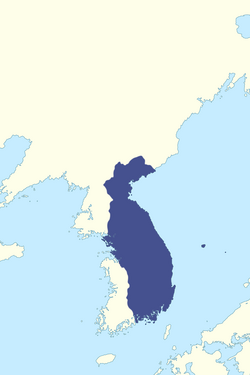
Back مملكة شلا Arabic Şila krallığı Azerbaijani شیلا AZB Silla BAR Сіла (дзяржава) Byelorussian Сила (държава) Bulgarian Kraljevstvo Sila BS Silla (Corea) Catalan Sĭng-lò̤ CDO شیللا CKB
This article needs additional citations for verification. (January 2023) |
Silla 新羅 (Hanja) 신라 (Hangul) 徐羅伐 (Old Korean) Yale: Syerapel (RR: Seorabeol) Pronunciation: [sʌɾabʌɭ] Phonetic Hangul: [서라벌] 斯羅火 (Old Korean) Sïrapïr (Japanese linguistic notation) | |||||||||||||
|---|---|---|---|---|---|---|---|---|---|---|---|---|---|
| 57 BCE – 935 CE | |||||||||||||
 Pre-Later Silla at its height in the 6th century. | |||||||||||||
| Capital | Seorabeol[a][b] | ||||||||||||
| Common languages | Old Korean, Classical Chinese, (literary)[1] | ||||||||||||
| Religion | Korean ethnic folk religion/Shamanism (State Religion: 57 BCE – 527 CE), Buddhism (527 CE – 935 CE), Confucianism, Taoism, Islam[2][3] | ||||||||||||
| Government | Monarchy | ||||||||||||
| King | |||||||||||||
• 57 BCE–4 CE | Hyeokgeose (first) | ||||||||||||
• 57–80 | Talhae | ||||||||||||
• 356–402 | Naemul | ||||||||||||
• 540–576 | Jinheung | ||||||||||||
• 654–661 | Muyeol | ||||||||||||
• 661–681 | Munmu | ||||||||||||
• 927–935 | Gyeongsun (last) | ||||||||||||
| Legislature | Hwabaek | ||||||||||||
| History | |||||||||||||
• Establishment | 57 BCE | ||||||||||||
• Introduction of Buddhism | 530 | ||||||||||||
• Campaigns of King Jinheung | 551–585 | ||||||||||||
| 668–676 | |||||||||||||
| 668–935 | |||||||||||||
• Handover to the Goryeo | 935 CE | ||||||||||||
| Population | |||||||||||||
• 200 | 250,000[4] | ||||||||||||
• 660 | 1,000,000[5] | ||||||||||||
• 676 | 4,500,000[6] | ||||||||||||
| |||||||||||||
| Today part of | North Korea South Korea | ||||||||||||
| Silla | |
| Hangul | 신라 |
|---|---|
| Hanja | |
| Revised Romanization | Silla |
| McCune–Reischauer | Shilla |
| History of Korea |
|---|
 |
| Timeline |
|
|
| Monarchs of Korea |
| Silla |
|---|
| (Pre-unification) |
|
| Monarchs of Korea |
| Silla |
|---|
| (Post-unification) |
|
Silla (Korean: 신라; Korean pronunciation: [ɕiɭ.ɭa]; Old Korean: 徐羅伐 Syerapel, 斯羅火 Sïrapïr;[7] RR: Seorabeol; IPA: Korean pronunciation: [sʌɾabʌɭ]), alternatively Shilla, was a Korean kingdom that existed between 57 BCE[8] – 935 CE and located on the southern and central parts of the Korean Peninsula. Silla, along with Baekje and Goguryeo, formed the Three Kingdoms of Korea. Silla had the lowest population of approximately 850,000 people (170,000 households), which was significantly smaller than those of Baekje (3,800,000 people) and Goguryeo (3,500,000 people).[9]
Its foundation can be traced back to the semi-mythological figure of Hyeokgeose of Silla (Old Korean: *pulkunwuri, "light of the world"), of the Park clan. The country was first ruled intermittently by the Miryang Park clan for 232 years and the Wolseong Seok clan for 172 years and beginning with the reign of Michu Isageum the Gyeongju Kim clan for 586 years. Park, Seok and Kim have no contemporary attestations and went by the Old Korean names of 居西干 Geoseogan (1st century BCE), 次次雄 Chachaung (1st century CE), 泥師今 Isageum (Old Korean: *nisokum)[10] and 麻立干 Maripkan (5th-6th century)[11] instead. It began as a chiefdom in the Jinhan confederacy, part of the Samhan and after consolidating its power in the immediate area, conquered the Gaya confederacy. Eventually allying with Sui China and then Tang China, it eventually conquered the other two kingdoms, Baekje in 660 and Goguryeo in 668. Thereafter, Unified Silla occupied most of the Korean Peninsula, while the northern part re-emerged as Balhae, a successor-state of Goguryeo. After nearly 1,000 years of rule, Silla fragmented into the brief Later Three Kingdoms of Silla, Later Baekje, and Taebong, handing over power to Goryeo in 935.[12]
Cite error: There are <ref group=lower-alpha> tags or {{efn}} templates on this page, but the references will not show without a {{reflist|group=lower-alpha}} template or {{notelist}} template (see the help page).
- ^ Lee 1984, pp. 83–84.
- ^ Lee (1991) reviews the writings of more than 15 Arabic geographers on Silla, which most refer to as al-sila or al-shila.
- ^ Lee (1991, p. 26) cites the 10th-century chronicler Mas'udi.
- ^ <경북신문>,신라의 인구수를 살펴보면, 중국측 기록에 나타나는 3세기 중엽경 진한과 변한의 인구는 25만 명 정도로 추정된다.
- ^ <삼국사기>,신라의 인구수는 '삼국사기'를 보면 668년에 고구려를 정벌하는데 20만 명의 병력을 동원한 사실이 나타난다. 이 20만 명은 군역의 의무를 지닌 정남이 차지하는 비율이 '신라촌락문서'에는 21%에 해당하고 있다. 이를 감안한다면 5배를 곱한 숫자 100만이 인구였음을 추정해 볼 수 있다.
- ^ 다윗(Davia)과 골리앗(Goliath) – 대구신문
- ^ Man'yōshū (Book 15): A New Translation Containing the Original Text, Kana Transliteration, Romanization, Glossing and Commentary. Global Oriental. August 2009. ISBN 978-900421299-2.
- ^ 57 BCE according to the Samguk Sagi; however Seth 2010 notes that "these dates are dutifully given in many textbooks and published materials in Korea today, but their basis is in myth; only Goguryeo may be traced back to a time period that is anywhere near its legendary founding."
- ^ Chosun Education (2016). "[ 기획 ] 역사로 살펴본 한반도 인구 추이".
- ^ "임금", Wiktionary, the free dictionary, 2023-08-04, retrieved 2023-12-14
- ^ "마립간", Wiktionary, the free dictionary, 2023-10-08, retrieved 2023-12-14
- ^ "사단법인 신라문화진흥원 – 신라의 역사와 문화". Archived from the original on 2008-03-21. Retrieved 2008-03-08. Retrieved on 2008-03-08
© MMXXIII Rich X Search. We shall prevail. All rights reserved. Rich X Search